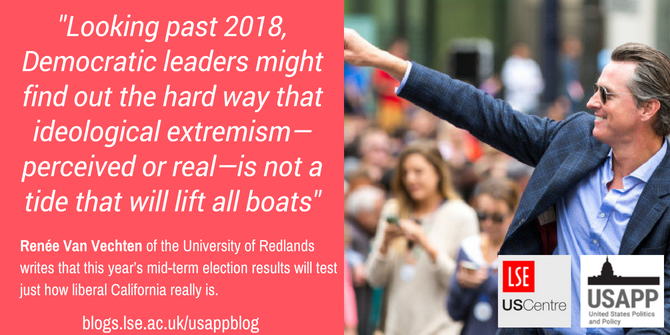 On June 5th Golden State voters selected Lieutenant Governor Democrat Gavin Newsom and businessman and Republican John Cox to face off in the fall gubernatorial election. Renée Van Vechten writes that Newsom is boldly liberal, even for a deep blue state like California. Only a new slate of more moderate state Democrats, she argues, will be able to rein in his tendencies which otherwise might prove too liberal – and expensive – for most Californians.
On June 5th Golden State voters selected Lieutenant Governor Democrat Gavin Newsom and businessman and Republican John Cox to face off in the fall gubernatorial election. Renée Van Vechten writes that Newsom is boldly liberal, even for a deep blue state like California. Only a new slate of more moderate state Democrats, she argues, will be able to rein in his tendencies which otherwise might prove too liberal – and expensive – for most Californians.
Just how “liberal” is too liberal for Californians? A fresh crop of elected officials will test their limits after the roiling 2018 November midterm election waters have calmed.
For eight years Governor Jerry Brown, a pragmatic intellectual, has navigated the “blue” waters by keeping the supermajority Democratic legislature in check, often saying “no” to redundant laws and big-ticket items such as universal health care that could jeopardize the budget, using multi-year surpluses to pay off public debt, and championing large-scale infrastructure projects that he considers necessary to meet the needs of 40 million residents, such as high-speed rail and a water tunnels project (“CalFix”) to ensure reliable water delivery for thirsty southerners. Brown’s grand-vision projects have been roundly criticized as exorbitant, and his opponents also lament skyrocketing housing prices and new gas taxes for road repairs that squeeze real dollars from household budgets. Republicans are also incensed by environmental regulations that they say make the state less business-friendly and assail pro-immigrant, “sanctuary state” laws that place California at the vanguard of anti-Trump politics.
Republicans are only 25 percent of registered voters in California, their levels having dropped even below that of “no party preference” voters, or registered independents, who number just above 25 percent. Nearly 45 percent identify as Democrats, meaning that California’s state government is overwhelmingly “blue” because most independents vote Democratic even as they reject partisan labels. Unless Republicans can persuade virtually all independent-minded voters plus some Democrats to join them, the tide will favor Democrats in the 2018 state elections and the new crew is likely to steer the ship of state into deeper liberal waters.
Former San Francisco mayor and now Lieutenant Governor Gavin Newsom will be at the helm. Having bested 26 other candidates and captured the top spot on the ticket with a third of the statewide vote (Democrats collected 62 percent overall), he endorses paid family leave, minimum wage hikes, marriage rights for all, and most daringly, universal healthcare—virtually all of which are opposed by the Republican gubernatorial contender, John Cox, who earned second place in the primary with just over 25 percent. Because of California’s “top two” primary system that enables the two candidates with the most votes to face off in the general election, the Republican Party was in danger of being washed out of the race as former Democratic Assembly Speaker and Los Angeles Mayor Antonio Villaraigosa fought Cox for the second spot. Now Cox has the chance to make his case that California is adrift and can’t afford yet more liberal politics. But a majority of the public is not on his side.

“Lieutenant Governor of California, Gavin Newsom and Jennifer Siebel, SF Pride 2015” by Thomas Hawk is licensed under CC BY NC 2.0
President Trump’s recent endorsement of Cox hardly provides a hook to bring independents on board. An opinion poll of likely voters conducted in May 2018 by the Public Policy Institute of California (PPIC) shows that while 75 percent of Republicans approve of the way Trump is handling his job as president, merely 36 percent of the state’s independents and 10 percent of Democrats do. Overwhelming majorities of Democrats and independents believe immigrants are a benefit the state, whereas most Republican voters do not. Californians are also pro-environment and have taxed themselves to breathe easier and drink cleaner water, voting to retain the state’s climate change law (AB32) and to endorse a single-use plastic bag ban. Republicans generally regard these laws as regulatory overreach.
There are limits to voters’ embrace of pro-social policies and their tolerance for taxes, however. Excluding California Republicans who reject the very idea of state-managed health care by two-thirds, a majority of adults favor such a plan, but their support drops by more than twenty points if it requires raising taxes. With a new, single-payer system that would cost upwards of $400 billion according to a state legislative committee analysis—twice the amount of the annual state budget—Newsom’s initiatives may be bold, but he is headed toward uncharted waters.
Democrats are likely to maintain their supermajority status in the state Assembly and also may regain it in the upper house, potentially giving Newsom the unfettered chance he needs to pursue his policy agenda. Buoyed by fellow Democrats, in office he will put his campaign slogan to the test: “Courage. For a change.”
That’s where the top-two primary, combined with districting effects, may start to matter in a new and different way. Although legislative scholars haven’t found much evidence that the top-two primary has moderated the legislature markedly, which was a principal goal of political reformers, they have noted that more Democratic moderates are serving in the legislature. Those representatives benefit from the support of anti-Trump independent voters. With the help of Governor Jerry Brown and his veto pen, for the most part they have kept extremism at bay. For instance, only 7.6 percent of 197 bills labeled “job killers” by the California Chamber of Commerce from 2011 to 2017 became law. That’s a pretty good score.
With an emboldened liberal Democrat as governor come December 2018, a moderate (but still left-of-center) bloc in the legislature may have the chance to emerge as the greater check on fellow Democrats who want to shift the agenda even further leftward, playing the role Brown once did. California government may be deep blue, but the state’s electorate is a far lighter hue. Moderating forces have kept the ship of state from sinking, and looking past 2018, Democratic leaders might find out the hard way that ideological extremism—perceived or real—is not a tide that will lift all boats.
Please read our comments policy before commenting.
Note: This article gives the views of the author, and not the position of USApp– American Politics and Policy, nor of the London School of Economics.
Shortened URL for this post: http://bit.ly/2tFq9Js
About the author
 Renée Van Vechten – University of Redlands
Renée Van Vechten – University of Redlands
Renée Bukovchik Van Vechten earned her doctorate in Political Science from the University of California, Irvine. She is a professor of Political Science at the University of Redlands in southern California, where she specializes in teaching, researching, and writing about US and California politics, with particular focus on legislative processes. Her text, California Politics: A Primer, is in its fifth edition (CQ Press, 2019), and presages a more comprehensive, forthcoming textbook (The Logic of California Politics).





